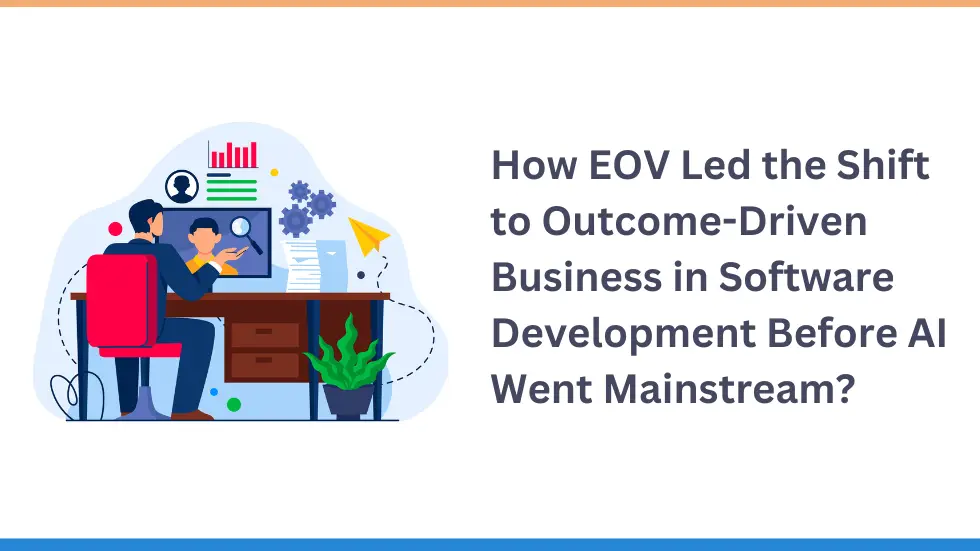In an era where Artificial Intelligence (AI) dominates enterprise conversations, companies are rapidly integrating AI into their products and processes.
But long before AI became a buzzword, EmbarkingOnVoyage (EOV) was pioneering a different kind of transformation—anchored in Outcome-Driven Business in Software Development.
While many organizations were fixated on deliverables like code, features, or system rollouts, EOV focused on a more strategic question:
What tangible business value are we delivering?”
This outcome-first mindset positioned EOV as a forward-thinking partner for enterprises, startups, and seed-stage companies—offering a blueprint where software development strategies are shaped by outcomes, not outputs.
Section 1: From Outputs to Business Outcomes—A Shift in Thinking
Traditionally, software success was measured by delivery speed or technical features. But these metrics often fail to reflect actual business performance or customer impact.
EOV recognized early on that a shift was needed—from an output-centric model to one focused on business outcomes in software development.
Their approach was guided by questions like:
- What strategic goals are we enabling?
- Will this solution improve customer experience, revenue, or efficiency?
- How will we measure the success of this product post-deployment?
This value-driven development model formed the foundation of EOV’s delivery philosophy.
Section 2: EOV’s Framework for Outcome-Driven Success
EOV didn’t just talk about outcomes—they operationalized them through a robust, repeatable framework tailored to each engagement.
1. Business Discovery Before Code
Before any technical execution, EOV conducts in-depth discovery with stakeholders to understand the business environment, pain points, and goals.
2. Co-Creation of Business KPIs
Instead of imposing metrics, EOV co-creates KPIs with clients—such as improving retention, lowering churn, or boosting lead conversion—aligning every project to measurable success.
3. Strategic Product Roadmaps
Roadmaps aren’t feature-driven—they’re business-priority driven. Features are selected based on their ability to move KPIs, not just technical feasibility.
4. Agile Feedback and Continuous Alignment
EOV uses agile not just for iteration, but for ongoing validation of outcomes. Sprint reviews include both technical demos and KPI progress.
5. Transparent Value Demonstration
At every milestone, EOV delivers dashboards and reports that quantify business impact—not just task completion.
Section 3: Real Business Wins from Outcome-Based Software Delivery
B2B SaaS CRM Overhaul
A SaaS provider sought CRM modernization. EOV focused on sales pipeline improvement, integrating AI for predictive lead scoring.
Result: 20% rise in lead-to-customer conversion in 6 months.
Retail Logistics Optimization
Partnering with a global retailer, EOV streamlined operations using real-time analytics and automation.
Result: 15% logistics cost reduction and improved delivery reliability.
Healthcare Engagement Dashboard
For a hospital chain, EOV built a behavioral analytics-driven dashboard to encourage patient follow-ups.
Result: 30% increase in follow-up appointment adherence.
Fintech App for European Market
Instead of launching feature-heavy apps, EOV prioritized user retention and experience design.
Result: 40% boost in monthly active users within three months.
These examples highlight how outcome-driven business in software development can lead to quantifiable success across industries.
Section 4: AI in Enterprises—Still Chasing Outcomes
The timeline of enterprise AI adoption has evolved:
- Early 2010s: Basic automation and rule engines
- Mid-2010s: Predictive analytics and machine learning
- 2020s onward: Generative AI, NLP, and contextual decision-making
Despite the excitement, many enterprises still fail to translate AI investments into real business outcomes.
EOV’s model avoids this trap. AI is used only where it aligns with client outcomes—such as increasing engagement, reducing costs, or improving operations. For EOV, AI is a tool—not a trophy.
Section 5: Why EOV Was Ahead of the Curve
What makes EOV’s model future-proof?
✔ Outcome-First Culture
Technology trends shift, but business value remains the constant. EOV embedded this thinking from the beginning.
✔ Custom KPIs and Client Alignment
Each project is mapped to unique, client-specific KPIs—making success measurable and meaningful.
✔ Trusted, Strategic Partnerships
With a results-oriented approach, EOV has nurtured long-term partnerships. Clients view them not as vendors, but as strategic collaborators.
Section 6: What Today’s Enterprises Can Learn from EOV
As organizations race toward AI adoption and digital innovation, EOV’s playbook offers timeless advice:
1. Don’t Chase Technology—Chase Business Transformation
Adopt technologies like AI only when they drive clear, measurable business outcomes.
2. Build with Goals in Mind
Tie every sprint, feature, and release back to business KPIs.
3. Make Software a Growth Enabler
Shift the role of software from support to strategy—just like EOV does.
Conclusion: Outcome-Driven Business is the Future of Software Development
In a world dazzled by the possibilities of AI and innovation, EOV’s success proves that software’s true value lies in delivering outcomes—not outputs.
By adopting an Outcome-Driven Business in Software Development, EOV has helped enterprises focus on what truly matters—growth, efficiency, and measurable success.
For startups, seed fund companies, and global enterprises alike, the message is clear:
📌 Let your business goals lead the way. Then let technology serve them—intelligently, efficiently, and measurably.
Additional Resources:
